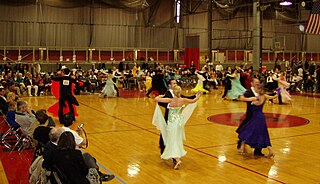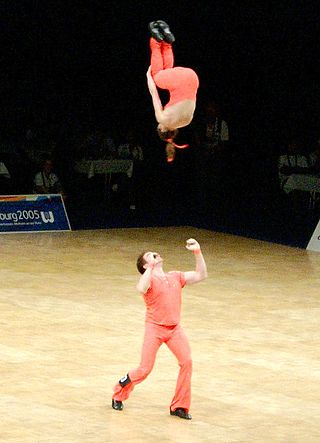This article includes a list of references, related reading, or external links, but its sources remain unclear because it lacks inline citations .(November 2018) |
Double bugg (Swedish : Dubbelbugg) is a Swedish swing dance.
This article includes a list of references, related reading, or external links, but its sources remain unclear because it lacks inline citations .(November 2018) |
Double bugg (Swedish : Dubbelbugg) is a Swedish swing dance.
Double bugg is more or less a competitive dance within the BRR dance family administered by the Swedish Dancesport Federation. The dance style has its background in another typical and invented Swedish dance style, namely Bugg. Bugg comes originally from Lindy Hop (Jitterbug).
Double bugg is danced by three persons, especially a man and two women. Variations occur however. Double bugg is mostly performed at dance competitions, but sometimes among social dancers. The dance arose during the 80s due to a lack of men wanting to dance. Then it was discovered that a man could dance the Swedish partner dance Bugg with two women concurrent. Suddenly a new dance style in Sweden was invented, double bugg.
Today double bugg is a small formation dance consisting of three people. The formation of different patterns and formations, for example lines, circles, triangles are apart from changing place between the dancers, one of several main features in double bugg. The essence of the dance is free and is taken from some other Swedish BRR dances: Bugg, Lindy Hop, Boogie Woogie and Rock and Roll (dance). Double bugg is mainly danced to modern pop or rock'n'roll music.

Ballroom dance is a set of European partner dances, which are enjoyed both socially and competitively around the world, mostly because of its performance and entertainment aspects. Ballroom dancing is also widely enjoyed on stage, film, and television.

East Coast Swing (ECS) is a form of social partner dance. It belongs to the group of swing dances. It is danced under fast swing music, including: big band, rock and roll, rockabilly, and boogie-woogie.

The Charleston is a dance named after the harbor city of Charleston, South Carolina. The rhythm was popularized in mainstream dance music in the United States by a 1923 tune called "The Charleston" by composer/pianist James P. Johnson, which originated in the Broadway show Runnin' Wild and became one of the most popular hits of the decade. Runnin' Wild ran from 28 October 1923 through 28 June 1924. The Charleston dance's peak popularity occurred from mid-1926 to 1927.

Swing dance is a group of social dances that developed with the swing style of jazz music in the 1920s–1940s, with the origins of each dance predating the popular "swing era". Hundreds of styles of swing dancing were developed; those that have survived beyond that era include Charleston, Balboa, Lindy Hop, and Collegiate Shag. Today, the best-known of these dances is the Lindy Hop, which originated in Harlem in the early 1930s. While the majority of swing dances began in African-American communities as vernacular African-American dances, some influenced swing-era dances, like Balboa, developed outside of these communities.

Partner dances are dances whose basic choreography involves coordinated dancing of two partners, as opposed to individuals dancing alone or individually in a non-coordinated manner, and as opposed to groups of people dancing simultaneously in a coordinated manner.

The World DanceSport Federation (WDSF), formerly the International DanceSport Federation (IDSF), is the international governing body of DanceSport and Para DanceSport, as recognised by the International Olympic Committee (IOC) and the International Paralympic Committee (IPC).

Dancesport is competitive ballroom dancing, as contrasted to social or exhibition dancing. In the case of Para dancesport, at least one of the dancers is in a wheelchair.
Formation dance is a style of ballroom dancing. It is pattern or shadow team dancing by couples in a formation team. The choreography may be based on a particular dance or a medley of dances. Formation dancing may be done for exhibition or for competition between teams. There is also a type of formation in Bhangra.

Frank Manning was an American dancer, instructor, and choreographer. Manning is considered one of the founders of Lindy Hop, an energetic form of the jazz dance style known as swing.

The Hot Shots is a collective name for two closely related Swedish dance companies based in Stockholm, Sweden: The Rhythm Hot Shots and the Harlem Hot Shots. The Hot Shots specialize in faithful reproductions of African-American dance scenes in American films from the 1920s, 30s, and 40s. Dances that they perform include Lindy Hop, Tap dance, Cakewalk, Charleston, and Black Bottom. The members of the Hot Shots are also respected dance instructors and accomplished social dancers. The goals of The Rhythm Hot Shots and the Harlem Hot Shots are the same.
World Rock'n'Roll Confederation (WRRC) was registered in 1984, although its history traces to 1974. It is an umbrella organization for national professional and amateur Rock and Roll dancesport federations. Its statute that it "aims at promoting the physical training of its members by means of sporting activities in the form of Rock'n'Roll dance tournaments, including the acrobatic variations as well as Rock'n'Roll and Boogie Woogie, Lindy Hop, Formation and alternative styles in line with the rules and sporting presentations". The registered office is in Neuhausen am Rheinfall, canton of Schaffhausen, Switzerland.

Boogie-woogie dance is a European variation of swing dance often done competitively that developed in the 1940s. Although its name derives from the boogie-woogie genre of music, it is most often danced to rock music. The form is cited in Madonna's hit single "Music"

Acrobatic rock and roll is a fast, athletic, physically demanding form of partner dance that originated from Lindy Hop but has evolved to a choreographed sport, often done in formal competition. It is danced by both couples and groups, either all-female or four to eight couples together.

Herräng Dance Camp is the largest annual dance camp that focuses on lindy hop, boogie woogie, tap dance, jazz dance, and balboa. It is held annually in July in Herräng, Sweden, and focuses both on instruction and dancing.
Swedish Dancesport Federation (DSF) administers all dancesport in Sweden. The association was formed on February 25, 1968, and is one of 68 different sports federations in Sweden. DSF became a member of the Swedish Sports Confederation (RF) in 1977, which administers all sports in Sweden. Apart from this membership Swedish Dancesport Federation also is a member of the International Dancesport Federation (IDSF) from June 19, 2011, known as the World DanceSport Federation (WDSF) and the World Rock'n'Roll Confederation (WRRC). The office lies in Farsta, Stockholm.
Bugg is a common dance style in Sweden and is very popular on the dancefloors, when dansbands play. Bugg is a four-step dance and performed at different paces. Bugg is a partner dance and follows certain basic rules, but is essentially improvised, with the woman following the man's lead. Acrobatic moves are not allowed on national or international dancecompetitions. Swedish Bugg belongs to the swing dance family and closely resembles Modern Jive.
Oxford University Dancesport Club (OUDC) is Oxford University's largest sports club and is the second largest club at the university after the Oxford Union. Founded in 1968 it currently has an annual membership of around 800 members. It runs professionally taught classes in the following dance styles:

The Lindy Hop is an American dance which was born in the African-American communities of Harlem, New York City, in 1928 and has evolved since then. It was very popular during the swing era of the late 1930s and early 1940s. Lindy is a fusion of many dances that preceded it or were popular during its development but is mainly based on jazz, tap, breakaway, and Charleston. It is frequently described as a jazz dance and is a member of the swing dance family.